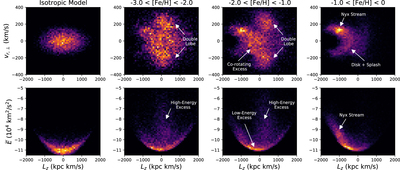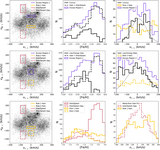Image Details

Caption: Figure 1.
Heat maps of kinematic properties of an isotropic halo model (left column) and the Gaia sample of local dwarf stars (three right columns, separated by metallicity as labeled at the top). The top row shows v r,⊥ vs. L z , and the bottom row shows ﹩\widetilde{E}﹩ vs. L z . Arrows and labels identify substructure. At low metallicities, the dwarf star population in the solar region appears similar to an isotropic halo background plus a nonrotating (L z ∼ 0) RME at higher energies. At intermediate metallicities, the isotropic component is still evident, but at high energies, the population is dominated by a retrograde RME, and at low energies, there are an excess of prograde stars and an overdensity at L z = −1000 kpc km s−1. At high metallicities, the dwarf stars are primarily made up of the L z = −1000 kpc km s−1 overdensity plus a crescent of disk/Splash stars bleeding up to positive L z . The missing semicircle of data at v r,⊥ = 0 and L z = −1500 kpc km s−1 is due to the proper motion cut that removes disk stars.
Copyright and Terms & Conditions
© 2022. The Author(s). Published by the American Astronomical Society.







